Management
VerifiedAdded on 2023/04/25
|11
|2701
|390
AI Summary
The paper is focused in the elaboration of one such organization in the form of Starbucks which is in definite need to restructure some of their key business policies to achieve higher preferences of the customers.
Contribute Materials
Your contribution can guide someone’s learning journey. Share your
documents today.
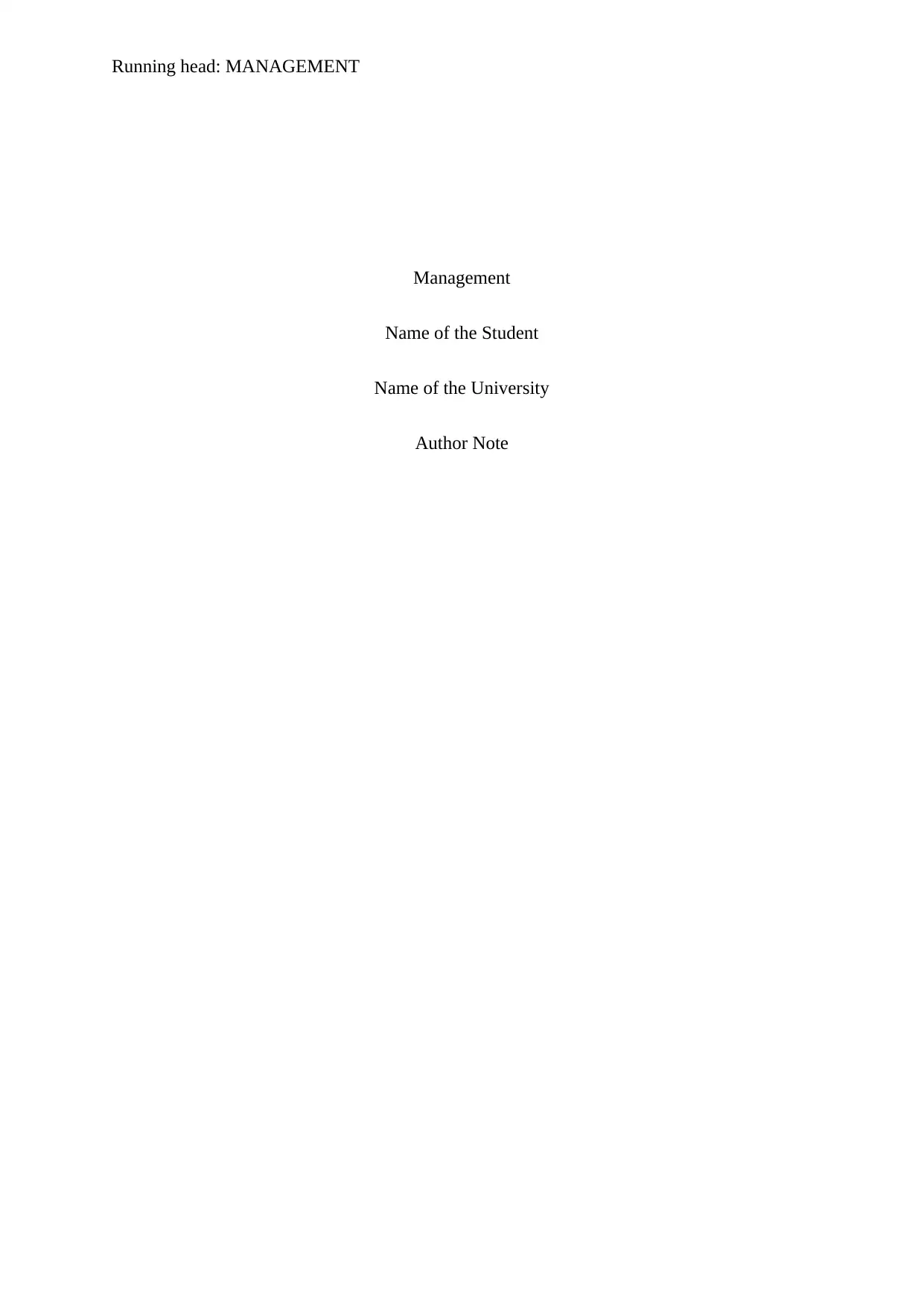
Running head: MANAGEMENT
Management
Name of the Student
Name of the University
Author Note
Management
Name of the Student
Name of the University
Author Note
Secure Best Marks with AI Grader
Need help grading? Try our AI Grader for instant feedback on your assignments.

1MANAGEMENT
The modern business organizations are facing the impact of the tremendous
competition of the business industry. The continuous entry of the new organizations into the
market is one of the prime reason of the intense market competition. Under such situations,
the organizations are observed to try different strategies to cope up with the pressure of the
competition. Many of the business organizations of the modern generation are observed to
apply the competitive pricing policy and on the other hand, some of the organizations are
seen to focus on the improvement of the quality in their services as a strategy for the effective
management of the impact of the competition (Macchiavello and Morjaria 2017). The
changes in the strategies of the organizations are in need to be efficiently managed by the
organization to make sure that they achieve the desired success with the new strategy. The
paper is focused in the elaboration of one such organization in the form of Starbucks which is
in definite need to restructure some of their key business policies to achieve higher
preferences of the customers. I was able to work for the chosen organization during last year
where I faced that the organization is in need to change some of the key aspects of their
businesses. The paper provides the objectives of those changes, identifies the sponsors for
driving the change project and conducts a SWOT and Cost Benefit Analysis for the case.
Apart from this, the paper develops a timeline for the change project, evaluates the impact of
the change on the key stakeholders of the organization and portrays the plan for the effective
management of the challenges that are expected to be faced in the implementation of the
changes.
Overview and Rationale of the change project:
The chosen organization Starbucks is a global leader in the coffee shop industry. The
organization is able to develop their business in a significantly manner which is pretty evident
with the generation of 22.387 billion US dollars as revenue in the year 2017 (Starbucks.in.
2019). The chosen organization sells a wide range of food products starting from the coffee,
The modern business organizations are facing the impact of the tremendous
competition of the business industry. The continuous entry of the new organizations into the
market is one of the prime reason of the intense market competition. Under such situations,
the organizations are observed to try different strategies to cope up with the pressure of the
competition. Many of the business organizations of the modern generation are observed to
apply the competitive pricing policy and on the other hand, some of the organizations are
seen to focus on the improvement of the quality in their services as a strategy for the effective
management of the impact of the competition (Macchiavello and Morjaria 2017). The
changes in the strategies of the organizations are in need to be efficiently managed by the
organization to make sure that they achieve the desired success with the new strategy. The
paper is focused in the elaboration of one such organization in the form of Starbucks which is
in definite need to restructure some of their key business policies to achieve higher
preferences of the customers. I was able to work for the chosen organization during last year
where I faced that the organization is in need to change some of the key aspects of their
businesses. The paper provides the objectives of those changes, identifies the sponsors for
driving the change project and conducts a SWOT and Cost Benefit Analysis for the case.
Apart from this, the paper develops a timeline for the change project, evaluates the impact of
the change on the key stakeholders of the organization and portrays the plan for the effective
management of the challenges that are expected to be faced in the implementation of the
changes.
Overview and Rationale of the change project:
The chosen organization Starbucks is a global leader in the coffee shop industry. The
organization is able to develop their business in a significantly manner which is pretty evident
with the generation of 22.387 billion US dollars as revenue in the year 2017 (Starbucks.in.
2019). The chosen organization sells a wide range of food products starting from the coffee,
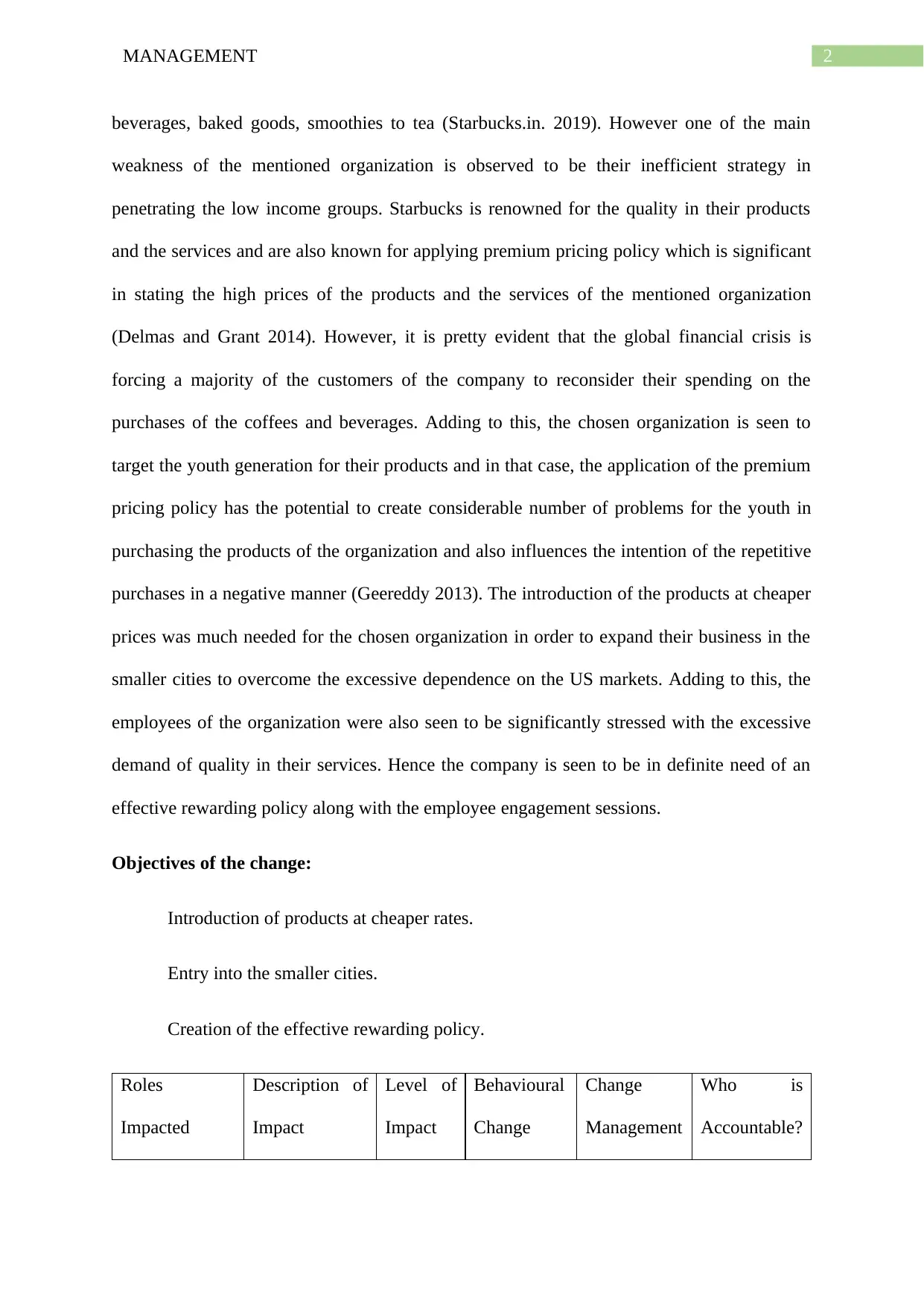
2MANAGEMENT
beverages, baked goods, smoothies to tea (Starbucks.in. 2019). However one of the main
weakness of the mentioned organization is observed to be their inefficient strategy in
penetrating the low income groups. Starbucks is renowned for the quality in their products
and the services and are also known for applying premium pricing policy which is significant
in stating the high prices of the products and the services of the mentioned organization
(Delmas and Grant 2014). However, it is pretty evident that the global financial crisis is
forcing a majority of the customers of the company to reconsider their spending on the
purchases of the coffees and beverages. Adding to this, the chosen organization is seen to
target the youth generation for their products and in that case, the application of the premium
pricing policy has the potential to create considerable number of problems for the youth in
purchasing the products of the organization and also influences the intention of the repetitive
purchases in a negative manner (Geereddy 2013). The introduction of the products at cheaper
prices was much needed for the chosen organization in order to expand their business in the
smaller cities to overcome the excessive dependence on the US markets. Adding to this, the
employees of the organization were also seen to be significantly stressed with the excessive
demand of quality in their services. Hence the company is seen to be in definite need of an
effective rewarding policy along with the employee engagement sessions.
Objectives of the change:
Introduction of products at cheaper rates.
Entry into the smaller cities.
Creation of the effective rewarding policy.
Roles
Impacted
Description of
Impact
Level of
Impact
Behavioural
Change
Change
Management
Who is
Accountable?
beverages, baked goods, smoothies to tea (Starbucks.in. 2019). However one of the main
weakness of the mentioned organization is observed to be their inefficient strategy in
penetrating the low income groups. Starbucks is renowned for the quality in their products
and the services and are also known for applying premium pricing policy which is significant
in stating the high prices of the products and the services of the mentioned organization
(Delmas and Grant 2014). However, it is pretty evident that the global financial crisis is
forcing a majority of the customers of the company to reconsider their spending on the
purchases of the coffees and beverages. Adding to this, the chosen organization is seen to
target the youth generation for their products and in that case, the application of the premium
pricing policy has the potential to create considerable number of problems for the youth in
purchasing the products of the organization and also influences the intention of the repetitive
purchases in a negative manner (Geereddy 2013). The introduction of the products at cheaper
prices was much needed for the chosen organization in order to expand their business in the
smaller cities to overcome the excessive dependence on the US markets. Adding to this, the
employees of the organization were also seen to be significantly stressed with the excessive
demand of quality in their services. Hence the company is seen to be in definite need of an
effective rewarding policy along with the employee engagement sessions.
Objectives of the change:
Introduction of products at cheaper rates.
Entry into the smaller cities.
Creation of the effective rewarding policy.
Roles
Impacted
Description of
Impact
Level of
Impact
Behavioural
Change
Change
Management
Who is
Accountable?
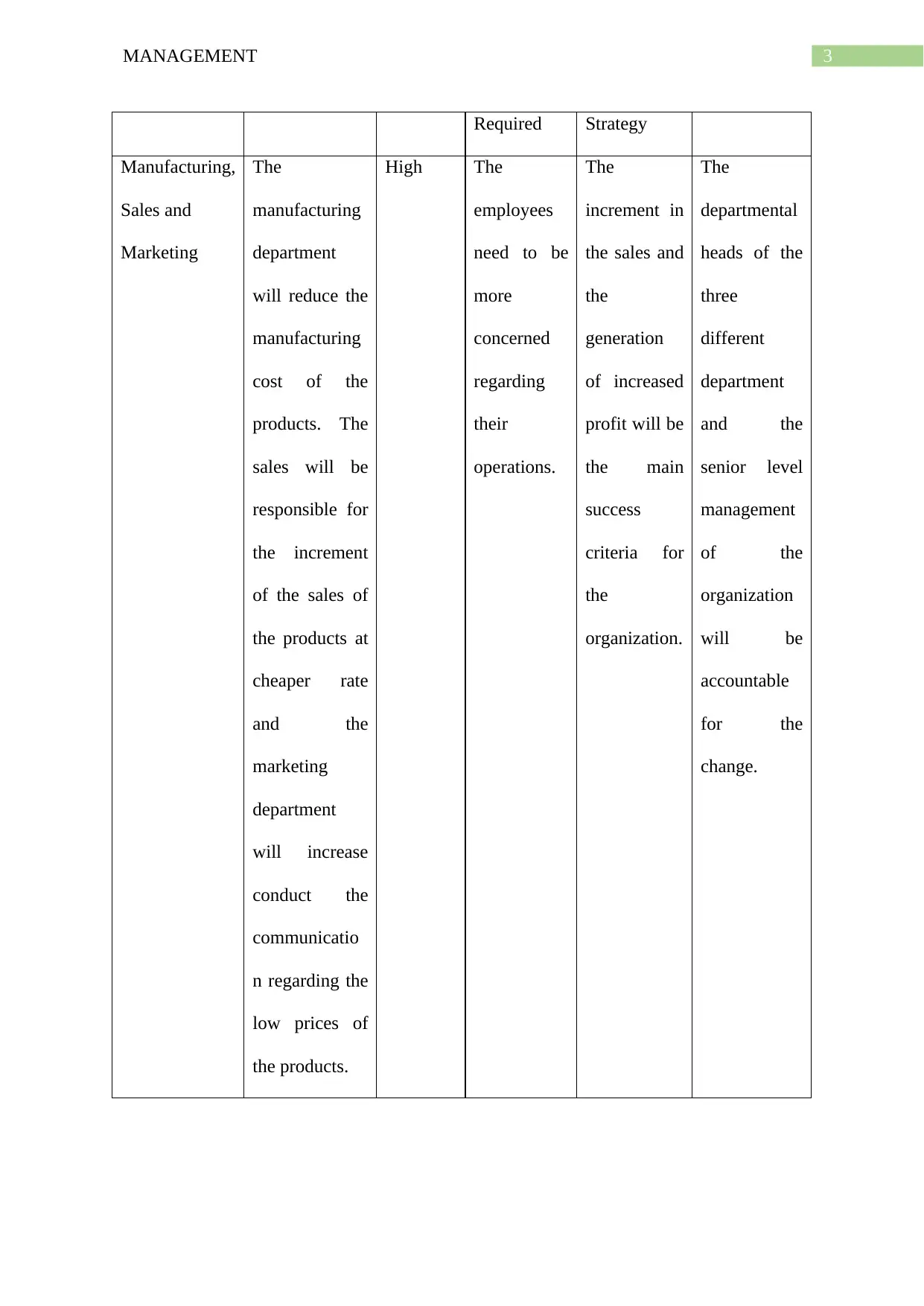
3MANAGEMENT
Required Strategy
Manufacturing,
Sales and
Marketing
The
manufacturing
department
will reduce the
manufacturing
cost of the
products. The
sales will be
responsible for
the increment
of the sales of
the products at
cheaper rate
and the
marketing
department
will increase
conduct the
communicatio
n regarding the
low prices of
the products.
High The
employees
need to be
more
concerned
regarding
their
operations.
The
increment in
the sales and
the
generation
of increased
profit will be
the main
success
criteria for
the
organization.
The
departmental
heads of the
three
different
department
and the
senior level
management
of the
organization
will be
accountable
for the
change.
Required Strategy
Manufacturing,
Sales and
Marketing
The
manufacturing
department
will reduce the
manufacturing
cost of the
products. The
sales will be
responsible for
the increment
of the sales of
the products at
cheaper rate
and the
marketing
department
will increase
conduct the
communicatio
n regarding the
low prices of
the products.
High The
employees
need to be
more
concerned
regarding
their
operations.
The
increment in
the sales and
the
generation
of increased
profit will be
the main
success
criteria for
the
organization.
The
departmental
heads of the
three
different
department
and the
senior level
management
of the
organization
will be
accountable
for the
change.
Secure Best Marks with AI Grader
Need help grading? Try our AI Grader for instant feedback on your assignments.

4MANAGEMENT
Drivers of the Project:
The main drivers of the project will be the shareholders and the customers of the
organization. After effective evaluation of the condition of the organization and the business
policy that they use, it is pretty evident that the organization is unable to attract the customers
of the low income groups. Hence the organization is in need to restructure their business
operations for the introduction of the products at cheaper rates. As the main objective of the
change is to serve the customers of the low income groups, their need will be considered as
an important factor for the change and in that case, the customers of the organization will be
considered as the driver of the change (Hausermann 2014). Adding to this, the shareholders
of the group are the responsible stakeholder segment for the consideration of the application
of the low pricing strategy for the products and the services of the organization.
The shareholders of the group are the only responsible group for the adjustment of the
pricing of the products. Hence the shareholder group will be a key driver of the change.
Adding to this, the organization is in need to enter the smaller cities and the towns with the
effective marketing and promotions of the products and for that, employees of the
organization will be a key driver of the change as well.
Impact on the stakeholders and timeline:
The effective implementation of the change will be significant for the shareholders as
they will be in need to compromise the high pricing of their products and at the same time,
they will have the chance to serve a larger number of customers. The increment in the
number of the customers will provide notable opportunity to the shareholders of the
organization in the improvement of the margin of the profit (Susanty and Kenny 2015). The
impact of the change on the customers of the organization will be noteworthy as the
Drivers of the Project:
The main drivers of the project will be the shareholders and the customers of the
organization. After effective evaluation of the condition of the organization and the business
policy that they use, it is pretty evident that the organization is unable to attract the customers
of the low income groups. Hence the organization is in need to restructure their business
operations for the introduction of the products at cheaper rates. As the main objective of the
change is to serve the customers of the low income groups, their need will be considered as
an important factor for the change and in that case, the customers of the organization will be
considered as the driver of the change (Hausermann 2014). Adding to this, the shareholders
of the group are the responsible stakeholder segment for the consideration of the application
of the low pricing strategy for the products and the services of the organization.
The shareholders of the group are the only responsible group for the adjustment of the
pricing of the products. Hence the shareholder group will be a key driver of the change.
Adding to this, the organization is in need to enter the smaller cities and the towns with the
effective marketing and promotions of the products and for that, employees of the
organization will be a key driver of the change as well.
Impact on the stakeholders and timeline:
The effective implementation of the change will be significant for the shareholders as
they will be in need to compromise the high pricing of their products and at the same time,
they will have the chance to serve a larger number of customers. The increment in the
number of the customers will provide notable opportunity to the shareholders of the
organization in the improvement of the margin of the profit (Susanty and Kenny 2015). The
impact of the change on the customers of the organization will be noteworthy as the
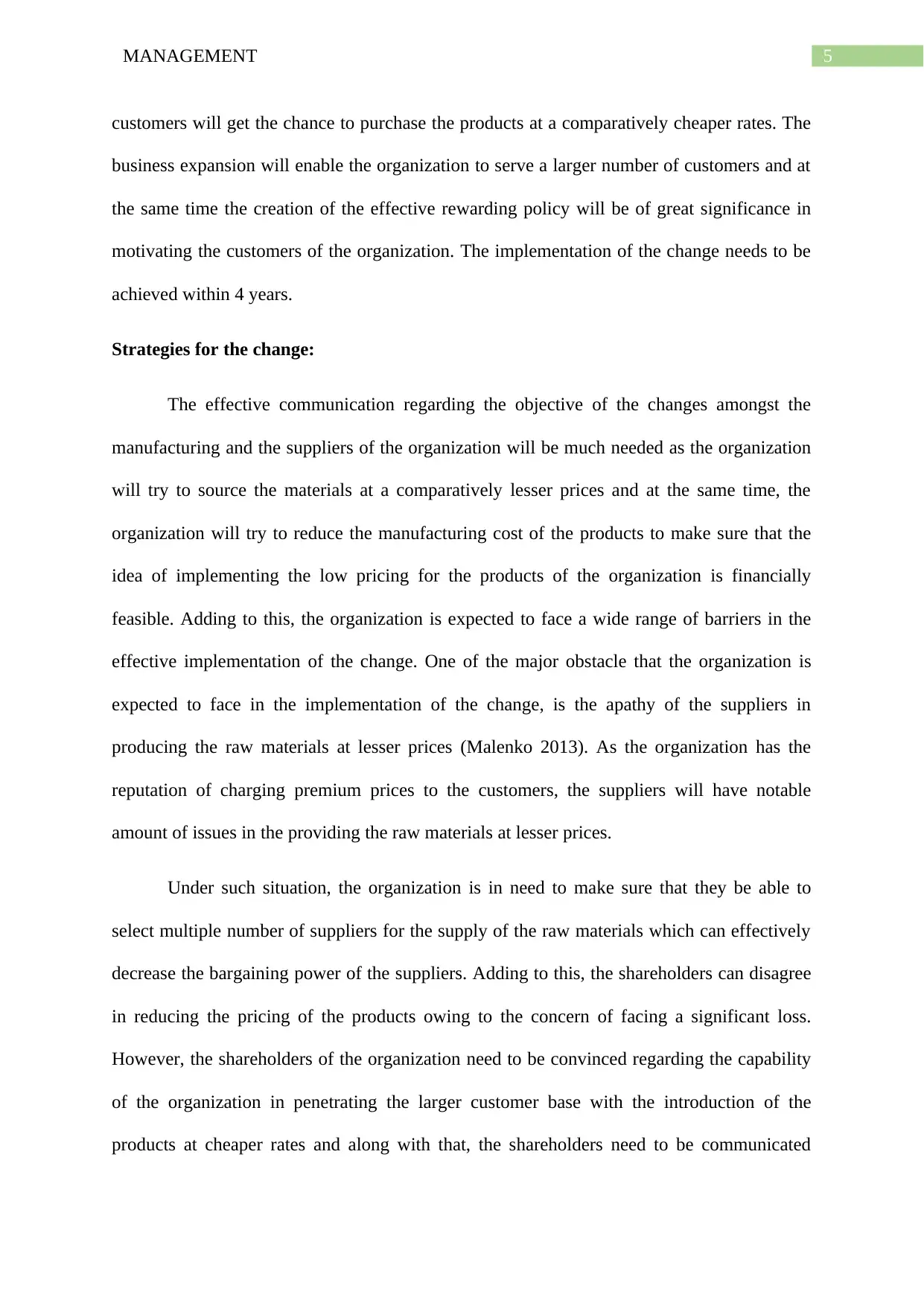
5MANAGEMENT
customers will get the chance to purchase the products at a comparatively cheaper rates. The
business expansion will enable the organization to serve a larger number of customers and at
the same time the creation of the effective rewarding policy will be of great significance in
motivating the customers of the organization. The implementation of the change needs to be
achieved within 4 years.
Strategies for the change:
The effective communication regarding the objective of the changes amongst the
manufacturing and the suppliers of the organization will be much needed as the organization
will try to source the materials at a comparatively lesser prices and at the same time, the
organization will try to reduce the manufacturing cost of the products to make sure that the
idea of implementing the low pricing for the products of the organization is financially
feasible. Adding to this, the organization is expected to face a wide range of barriers in the
effective implementation of the change. One of the major obstacle that the organization is
expected to face in the implementation of the change, is the apathy of the suppliers in
producing the raw materials at lesser prices (Malenko 2013). As the organization has the
reputation of charging premium prices to the customers, the suppliers will have notable
amount of issues in the providing the raw materials at lesser prices.
Under such situation, the organization is in need to make sure that they be able to
select multiple number of suppliers for the supply of the raw materials which can effectively
decrease the bargaining power of the suppliers. Adding to this, the shareholders can disagree
in reducing the pricing of the products owing to the concern of facing a significant loss.
However, the shareholders of the organization need to be convinced regarding the capability
of the organization in penetrating the larger customer base with the introduction of the
products at cheaper rates and along with that, the shareholders need to be communicated
customers will get the chance to purchase the products at a comparatively cheaper rates. The
business expansion will enable the organization to serve a larger number of customers and at
the same time the creation of the effective rewarding policy will be of great significance in
motivating the customers of the organization. The implementation of the change needs to be
achieved within 4 years.
Strategies for the change:
The effective communication regarding the objective of the changes amongst the
manufacturing and the suppliers of the organization will be much needed as the organization
will try to source the materials at a comparatively lesser prices and at the same time, the
organization will try to reduce the manufacturing cost of the products to make sure that the
idea of implementing the low pricing for the products of the organization is financially
feasible. Adding to this, the organization is expected to face a wide range of barriers in the
effective implementation of the change. One of the major obstacle that the organization is
expected to face in the implementation of the change, is the apathy of the suppliers in
producing the raw materials at lesser prices (Malenko 2013). As the organization has the
reputation of charging premium prices to the customers, the suppliers will have notable
amount of issues in the providing the raw materials at lesser prices.
Under such situation, the organization is in need to make sure that they be able to
select multiple number of suppliers for the supply of the raw materials which can effectively
decrease the bargaining power of the suppliers. Adding to this, the shareholders can disagree
in reducing the pricing of the products owing to the concern of facing a significant loss.
However, the shareholders of the organization need to be convinced regarding the capability
of the organization in penetrating the larger customer base with the introduction of the
products at cheaper rates and along with that, the shareholders need to be communicated
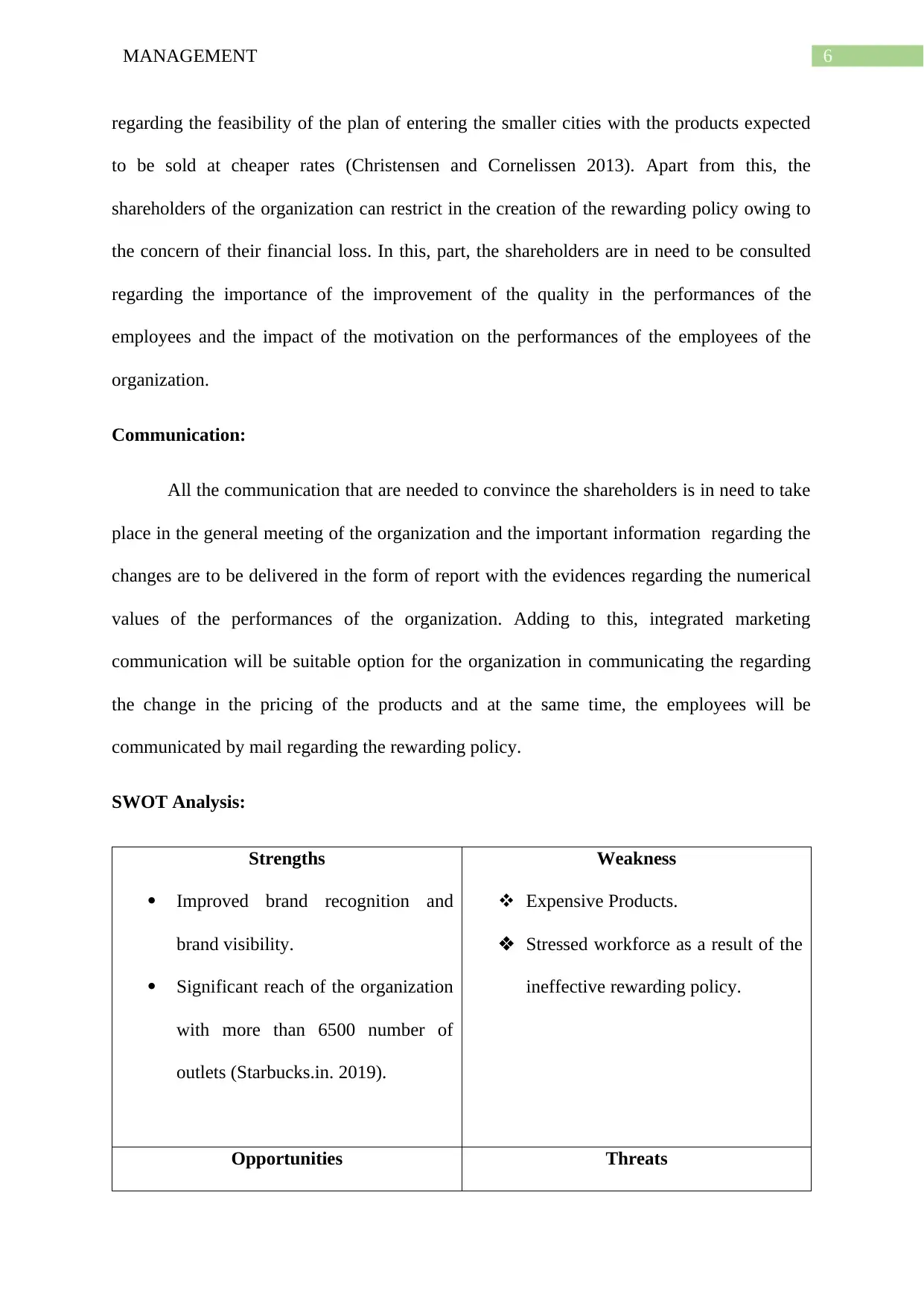
6MANAGEMENT
regarding the feasibility of the plan of entering the smaller cities with the products expected
to be sold at cheaper rates (Christensen and Cornelissen 2013). Apart from this, the
shareholders of the organization can restrict in the creation of the rewarding policy owing to
the concern of their financial loss. In this, part, the shareholders are in need to be consulted
regarding the importance of the improvement of the quality in the performances of the
employees and the impact of the motivation on the performances of the employees of the
organization.
Communication:
All the communication that are needed to convince the shareholders is in need to take
place in the general meeting of the organization and the important information regarding the
changes are to be delivered in the form of report with the evidences regarding the numerical
values of the performances of the organization. Adding to this, integrated marketing
communication will be suitable option for the organization in communicating the regarding
the change in the pricing of the products and at the same time, the employees will be
communicated by mail regarding the rewarding policy.
SWOT Analysis:
Strengths
Improved brand recognition and
brand visibility.
Significant reach of the organization
with more than 6500 number of
outlets (Starbucks.in. 2019).
Weakness
Expensive Products.
Stressed workforce as a result of the
ineffective rewarding policy.
Opportunities Threats
regarding the feasibility of the plan of entering the smaller cities with the products expected
to be sold at cheaper rates (Christensen and Cornelissen 2013). Apart from this, the
shareholders of the organization can restrict in the creation of the rewarding policy owing to
the concern of their financial loss. In this, part, the shareholders are in need to be consulted
regarding the importance of the improvement of the quality in the performances of the
employees and the impact of the motivation on the performances of the employees of the
organization.
Communication:
All the communication that are needed to convince the shareholders is in need to take
place in the general meeting of the organization and the important information regarding the
changes are to be delivered in the form of report with the evidences regarding the numerical
values of the performances of the organization. Adding to this, integrated marketing
communication will be suitable option for the organization in communicating the regarding
the change in the pricing of the products and at the same time, the employees will be
communicated by mail regarding the rewarding policy.
SWOT Analysis:
Strengths
Improved brand recognition and
brand visibility.
Significant reach of the organization
with more than 6500 number of
outlets (Starbucks.in. 2019).
Weakness
Expensive Products.
Stressed workforce as a result of the
ineffective rewarding policy.
Opportunities Threats
Paraphrase This Document
Need a fresh take? Get an instant paraphrase of this document with our AI Paraphraser
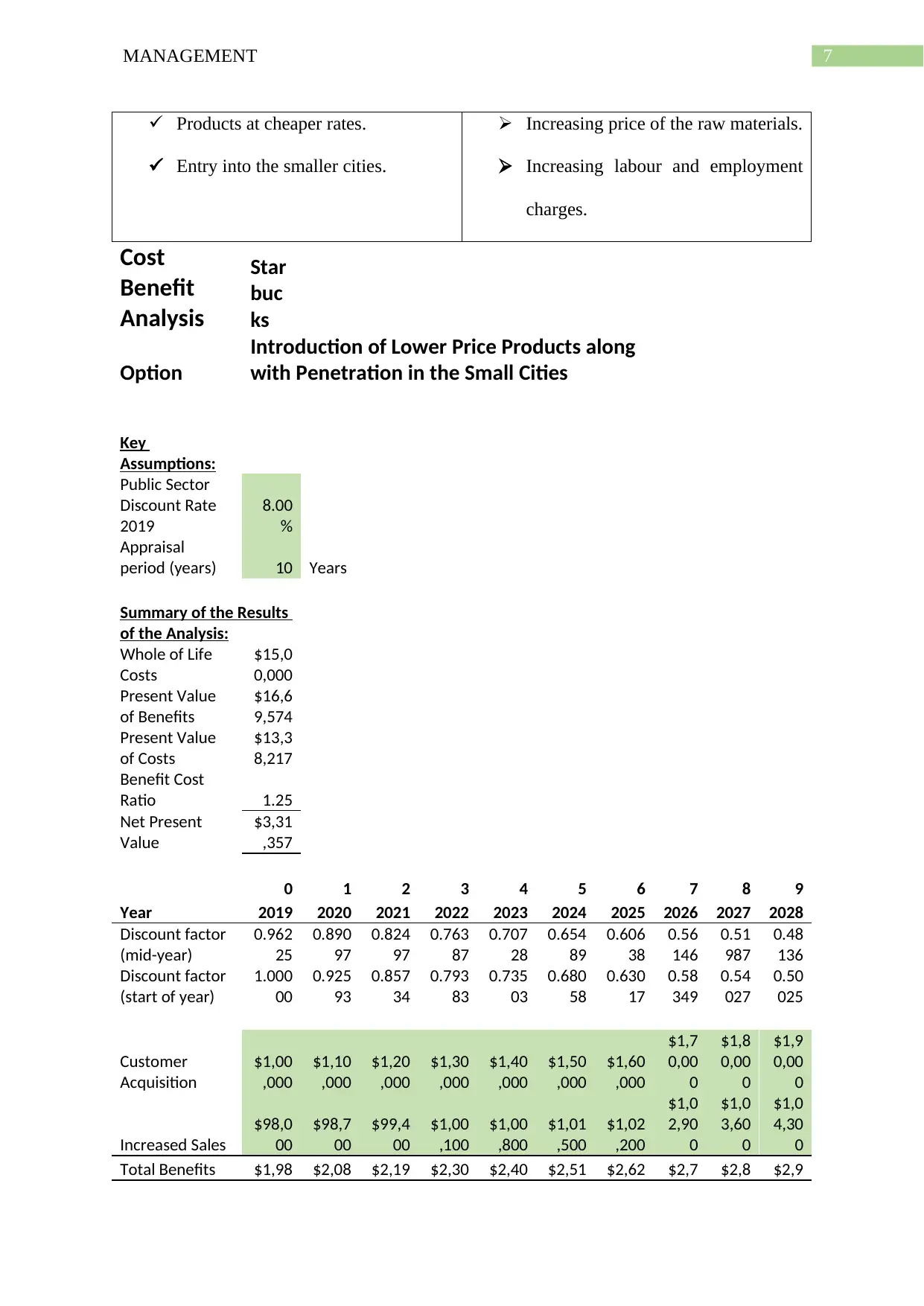
7MANAGEMENT
Products at cheaper rates.
Entry into the smaller cities.
Increasing price of the raw materials.
Increasing labour and employment
charges.
Cost
Benefit
Analysis
Star
buc
ks
Option
Introduction of Lower Price Products along
with Penetration in the Small Cities
Key
Assumptions:
Public Sector
Discount Rate
2019
8.00
%
Appraisal
period (years) 10 Years
Summary of the Results
of the Analysis:
Whole of Life
Costs
$15,0
0,000
Present Value
of Benefits
$16,6
9,574
Present Value
of Costs
$13,3
8,217
Benefit Cost
Ratio 1.25
Net Present
Value
$3,31
,357
0 1 2 3 4 5 6 7 8 9
Year 2019 2020 2021 2022 2023 2024 2025 2026 2027 2028
Discount factor
(mid-year)
0.962
25
0.890
97
0.824
97
0.763
87
0.707
28
0.654
89
0.606
38
0.56
146
0.51
987
0.48
136
Discount factor
(start of year)
1.000
00
0.925
93
0.857
34
0.793
83
0.735
03
0.680
58
0.630
17
0.58
349
0.54
027
0.50
025
Customer
Acquisition
$1,00
,000
$1,10
,000
$1,20
,000
$1,30
,000
$1,40
,000
$1,50
,000
$1,60
,000
$1,7
0,00
0
$1,8
0,00
0
$1,9
0,00
0
Increased Sales
$98,0
00
$98,7
00
$99,4
00
$1,00
,100
$1,00
,800
$1,01
,500
$1,02
,200
$1,0
2,90
0
$1,0
3,60
0
$1,0
4,30
0
Total Benefits $1,98 $2,08 $2,19 $2,30 $2,40 $2,51 $2,62 $2,7 $2,8 $2,9
Products at cheaper rates.
Entry into the smaller cities.
Increasing price of the raw materials.
Increasing labour and employment
charges.
Cost
Benefit
Analysis
Star
buc
ks
Option
Introduction of Lower Price Products along
with Penetration in the Small Cities
Key
Assumptions:
Public Sector
Discount Rate
2019
8.00
%
Appraisal
period (years) 10 Years
Summary of the Results
of the Analysis:
Whole of Life
Costs
$15,0
0,000
Present Value
of Benefits
$16,6
9,574
Present Value
of Costs
$13,3
8,217
Benefit Cost
Ratio 1.25
Net Present
Value
$3,31
,357
0 1 2 3 4 5 6 7 8 9
Year 2019 2020 2021 2022 2023 2024 2025 2026 2027 2028
Discount factor
(mid-year)
0.962
25
0.890
97
0.824
97
0.763
87
0.707
28
0.654
89
0.606
38
0.56
146
0.51
987
0.48
136
Discount factor
(start of year)
1.000
00
0.925
93
0.857
34
0.793
83
0.735
03
0.680
58
0.630
17
0.58
349
0.54
027
0.50
025
Customer
Acquisition
$1,00
,000
$1,10
,000
$1,20
,000
$1,30
,000
$1,40
,000
$1,50
,000
$1,60
,000
$1,7
0,00
0
$1,8
0,00
0
$1,9
0,00
0
Increased Sales
$98,0
00
$98,7
00
$99,4
00
$1,00
,100
$1,00
,800
$1,01
,500
$1,02
,200
$1,0
2,90
0
$1,0
3,60
0
$1,0
4,30
0
Total Benefits $1,98 $2,08 $2,19 $2,30 $2,40 $2,51 $2,62 $2,7 $2,8 $2,9
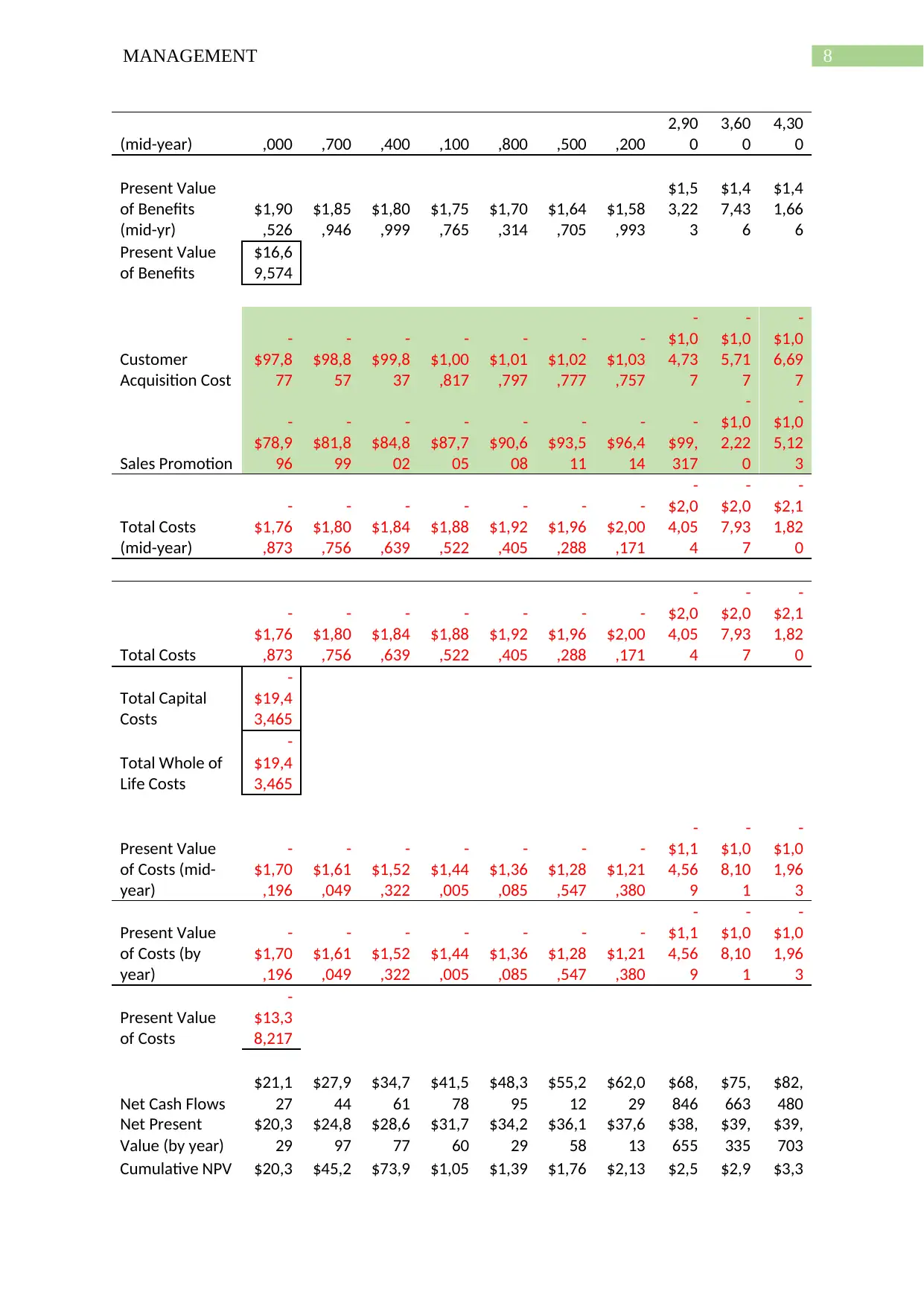
8MANAGEMENT
(mid-year) ,000 ,700 ,400 ,100 ,800 ,500 ,200
2,90
0
3,60
0
4,30
0
Present Value
of Benefits
(mid-yr)
$1,90
,526
$1,85
,946
$1,80
,999
$1,75
,765
$1,70
,314
$1,64
,705
$1,58
,993
$1,5
3,22
3
$1,4
7,43
6
$1,4
1,66
6
Present Value
of Benefits
$16,6
9,574
Customer
Acquisition Cost
-
$97,8
77
-
$98,8
57
-
$99,8
37
-
$1,00
,817
-
$1,01
,797
-
$1,02
,777
-
$1,03
,757
-
$1,0
4,73
7
-
$1,0
5,71
7
-
$1,0
6,69
7
Sales Promotion
-
$78,9
96
-
$81,8
99
-
$84,8
02
-
$87,7
05
-
$90,6
08
-
$93,5
11
-
$96,4
14
-
$99,
317
-
$1,0
2,22
0
-
$1,0
5,12
3
Total Costs
(mid-year)
-
$1,76
,873
-
$1,80
,756
-
$1,84
,639
-
$1,88
,522
-
$1,92
,405
-
$1,96
,288
-
$2,00
,171
-
$2,0
4,05
4
-
$2,0
7,93
7
-
$2,1
1,82
0
Total Costs
-
$1,76
,873
-
$1,80
,756
-
$1,84
,639
-
$1,88
,522
-
$1,92
,405
-
$1,96
,288
-
$2,00
,171
-
$2,0
4,05
4
-
$2,0
7,93
7
-
$2,1
1,82
0
Total Capital
Costs
-
$19,4
3,465
Total Whole of
Life Costs
-
$19,4
3,465
Present Value
of Costs (mid-
year)
-
$1,70
,196
-
$1,61
,049
-
$1,52
,322
-
$1,44
,005
-
$1,36
,085
-
$1,28
,547
-
$1,21
,380
-
$1,1
4,56
9
-
$1,0
8,10
1
-
$1,0
1,96
3
Present Value
of Costs (by
year)
-
$1,70
,196
-
$1,61
,049
-
$1,52
,322
-
$1,44
,005
-
$1,36
,085
-
$1,28
,547
-
$1,21
,380
-
$1,1
4,56
9
-
$1,0
8,10
1
-
$1,0
1,96
3
Present Value
of Costs
-
$13,3
8,217
Net Cash Flows
$21,1
27
$27,9
44
$34,7
61
$41,5
78
$48,3
95
$55,2
12
$62,0
29
$68,
846
$75,
663
$82,
480
Net Present
Value (by year)
$20,3
29
$24,8
97
$28,6
77
$31,7
60
$34,2
29
$36,1
58
$37,6
13
$38,
655
$39,
335
$39,
703
Cumulative NPV $20,3 $45,2 $73,9 $1,05 $1,39 $1,76 $2,13 $2,5 $2,9 $3,3
(mid-year) ,000 ,700 ,400 ,100 ,800 ,500 ,200
2,90
0
3,60
0
4,30
0
Present Value
of Benefits
(mid-yr)
$1,90
,526
$1,85
,946
$1,80
,999
$1,75
,765
$1,70
,314
$1,64
,705
$1,58
,993
$1,5
3,22
3
$1,4
7,43
6
$1,4
1,66
6
Present Value
of Benefits
$16,6
9,574
Customer
Acquisition Cost
-
$97,8
77
-
$98,8
57
-
$99,8
37
-
$1,00
,817
-
$1,01
,797
-
$1,02
,777
-
$1,03
,757
-
$1,0
4,73
7
-
$1,0
5,71
7
-
$1,0
6,69
7
Sales Promotion
-
$78,9
96
-
$81,8
99
-
$84,8
02
-
$87,7
05
-
$90,6
08
-
$93,5
11
-
$96,4
14
-
$99,
317
-
$1,0
2,22
0
-
$1,0
5,12
3
Total Costs
(mid-year)
-
$1,76
,873
-
$1,80
,756
-
$1,84
,639
-
$1,88
,522
-
$1,92
,405
-
$1,96
,288
-
$2,00
,171
-
$2,0
4,05
4
-
$2,0
7,93
7
-
$2,1
1,82
0
Total Costs
-
$1,76
,873
-
$1,80
,756
-
$1,84
,639
-
$1,88
,522
-
$1,92
,405
-
$1,96
,288
-
$2,00
,171
-
$2,0
4,05
4
-
$2,0
7,93
7
-
$2,1
1,82
0
Total Capital
Costs
-
$19,4
3,465
Total Whole of
Life Costs
-
$19,4
3,465
Present Value
of Costs (mid-
year)
-
$1,70
,196
-
$1,61
,049
-
$1,52
,322
-
$1,44
,005
-
$1,36
,085
-
$1,28
,547
-
$1,21
,380
-
$1,1
4,56
9
-
$1,0
8,10
1
-
$1,0
1,96
3
Present Value
of Costs (by
year)
-
$1,70
,196
-
$1,61
,049
-
$1,52
,322
-
$1,44
,005
-
$1,36
,085
-
$1,28
,547
-
$1,21
,380
-
$1,1
4,56
9
-
$1,0
8,10
1
-
$1,0
1,96
3
Present Value
of Costs
-
$13,3
8,217
Net Cash Flows
$21,1
27
$27,9
44
$34,7
61
$41,5
78
$48,3
95
$55,2
12
$62,0
29
$68,
846
$75,
663
$82,
480
Net Present
Value (by year)
$20,3
29
$24,8
97
$28,6
77
$31,7
60
$34,2
29
$36,1
58
$37,6
13
$38,
655
$39,
335
$39,
703
Cumulative NPV $20,3 $45,2 $73,9 $1,05 $1,39 $1,76 $2,13 $2,5 $2,9 $3,3
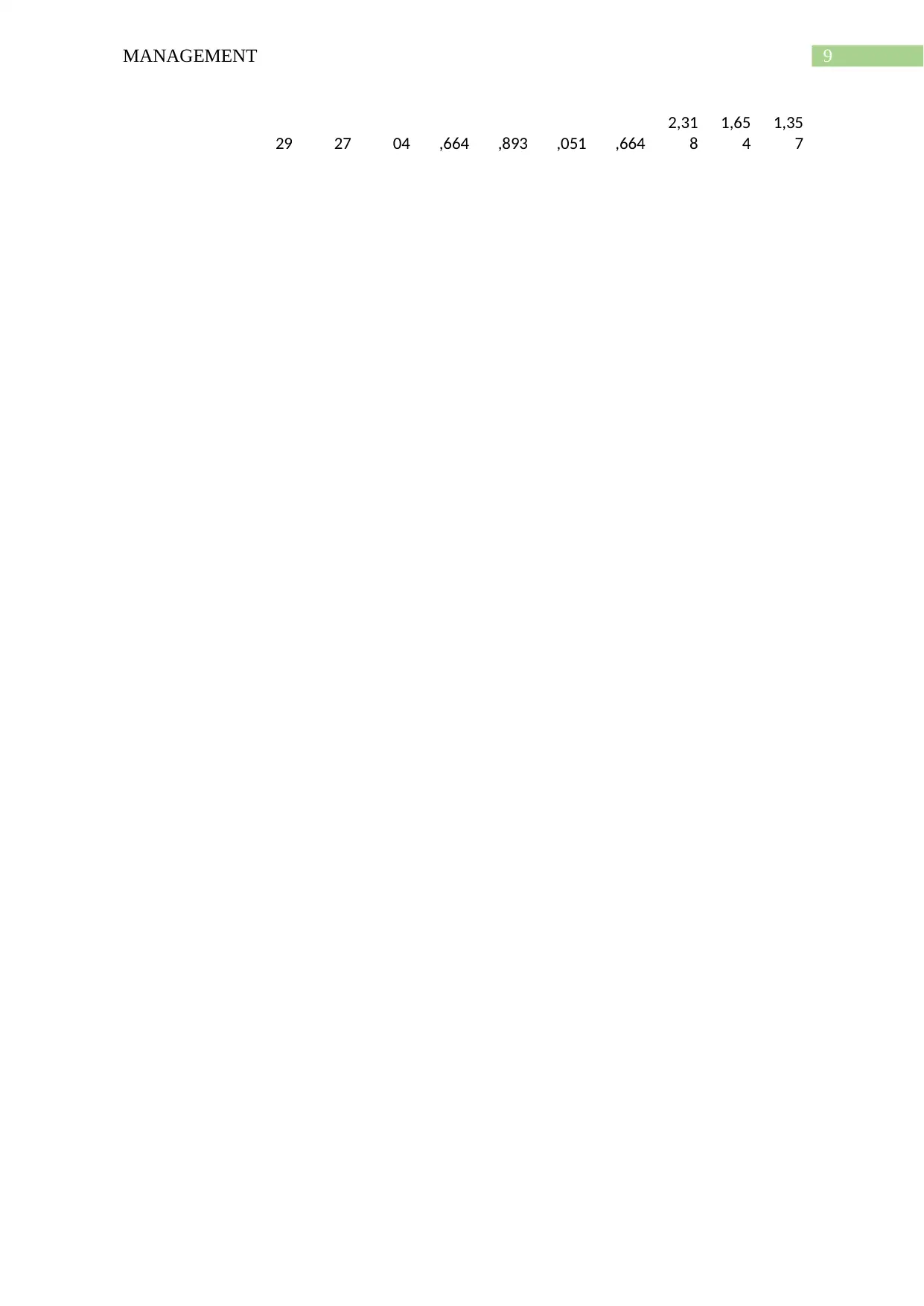
9MANAGEMENT
29 27 04 ,664 ,893 ,051 ,664
2,31
8
1,65
4
1,35
7
29 27 04 ,664 ,893 ,051 ,664
2,31
8
1,65
4
1,35
7
Secure Best Marks with AI Grader
Need help grading? Try our AI Grader for instant feedback on your assignments.
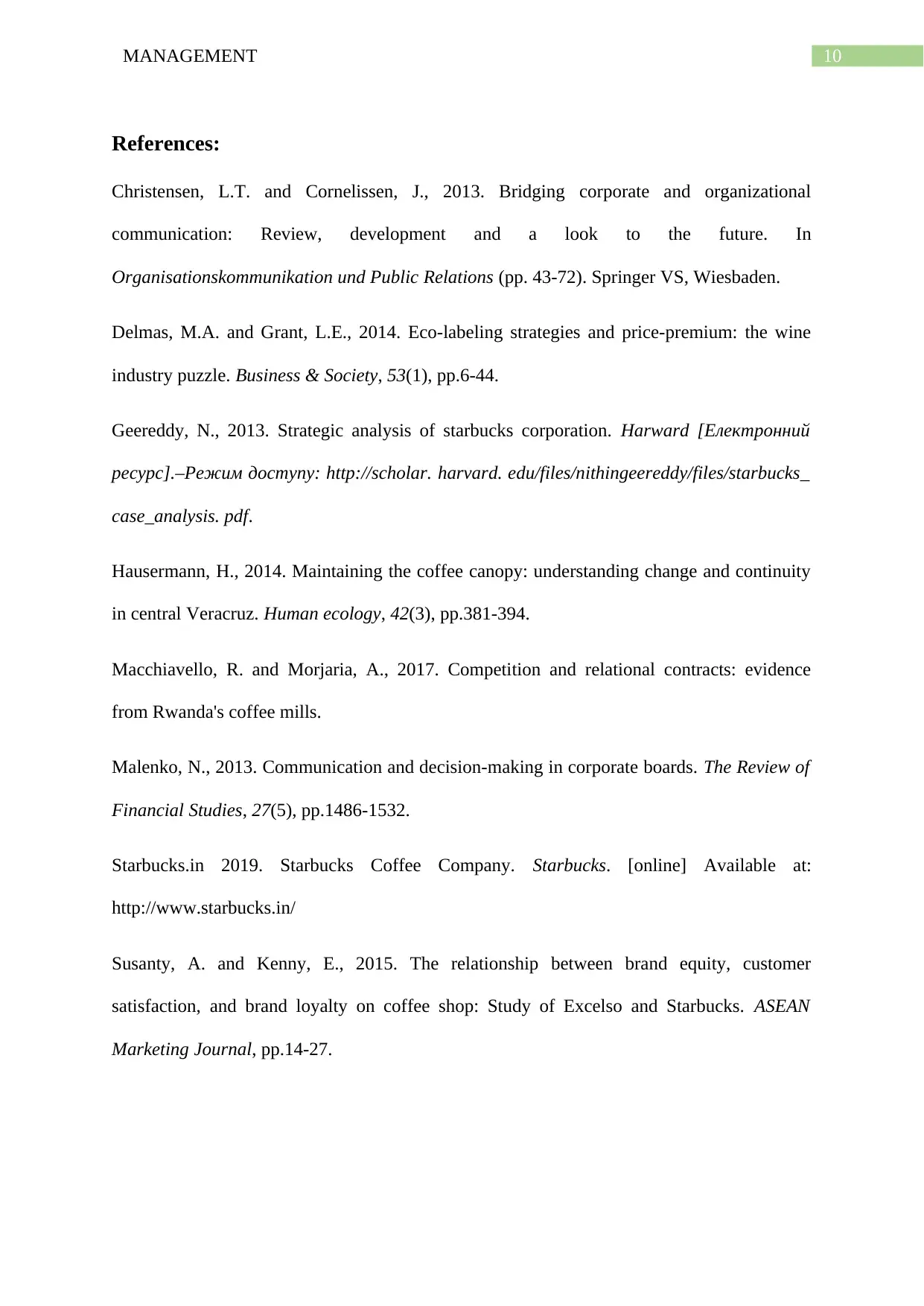
10MANAGEMENT
References:
Christensen, L.T. and Cornelissen, J., 2013. Bridging corporate and organizational
communication: Review, development and a look to the future. In
Organisationskommunikation und Public Relations (pp. 43-72). Springer VS, Wiesbaden.
Delmas, M.A. and Grant, L.E., 2014. Eco-labeling strategies and price-premium: the wine
industry puzzle. Business & Society, 53(1), pp.6-44.
Geereddy, N., 2013. Strategic analysis of starbucks corporation. Harward [Електронний
ресурс].–Режим доступу: http://scholar. harvard. edu/files/nithingeereddy/files/starbucks_
case_analysis. pdf.
Hausermann, H., 2014. Maintaining the coffee canopy: understanding change and continuity
in central Veracruz. Human ecology, 42(3), pp.381-394.
Macchiavello, R. and Morjaria, A., 2017. Competition and relational contracts: evidence
from Rwanda's coffee mills.
Malenko, N., 2013. Communication and decision-making in corporate boards. The Review of
Financial Studies, 27(5), pp.1486-1532.
Starbucks.in 2019. Starbucks Coffee Company. Starbucks. [online] Available at:
http://www.starbucks.in/
Susanty, A. and Kenny, E., 2015. The relationship between brand equity, customer
satisfaction, and brand loyalty on coffee shop: Study of Excelso and Starbucks. ASEAN
Marketing Journal, pp.14-27.
References:
Christensen, L.T. and Cornelissen, J., 2013. Bridging corporate and organizational
communication: Review, development and a look to the future. In
Organisationskommunikation und Public Relations (pp. 43-72). Springer VS, Wiesbaden.
Delmas, M.A. and Grant, L.E., 2014. Eco-labeling strategies and price-premium: the wine
industry puzzle. Business & Society, 53(1), pp.6-44.
Geereddy, N., 2013. Strategic analysis of starbucks corporation. Harward [Електронний
ресурс].–Режим доступу: http://scholar. harvard. edu/files/nithingeereddy/files/starbucks_
case_analysis. pdf.
Hausermann, H., 2014. Maintaining the coffee canopy: understanding change and continuity
in central Veracruz. Human ecology, 42(3), pp.381-394.
Macchiavello, R. and Morjaria, A., 2017. Competition and relational contracts: evidence
from Rwanda's coffee mills.
Malenko, N., 2013. Communication and decision-making in corporate boards. The Review of
Financial Studies, 27(5), pp.1486-1532.
Starbucks.in 2019. Starbucks Coffee Company. Starbucks. [online] Available at:
http://www.starbucks.in/
Susanty, A. and Kenny, E., 2015. The relationship between brand equity, customer
satisfaction, and brand loyalty on coffee shop: Study of Excelso and Starbucks. ASEAN
Marketing Journal, pp.14-27.
1 out of 11
Related Documents
Your All-in-One AI-Powered Toolkit for Academic Success.
+13062052269
info@desklib.com
Available 24*7 on WhatsApp / Email
![[object Object]](/_next/static/media/star-bottom.7253800d.svg)
Unlock your academic potential
© 2024 | Zucol Services PVT LTD | All rights reserved.




